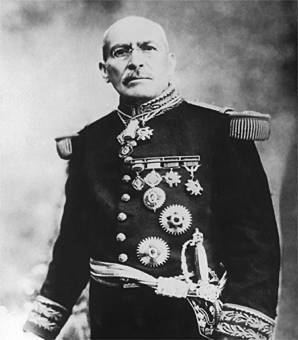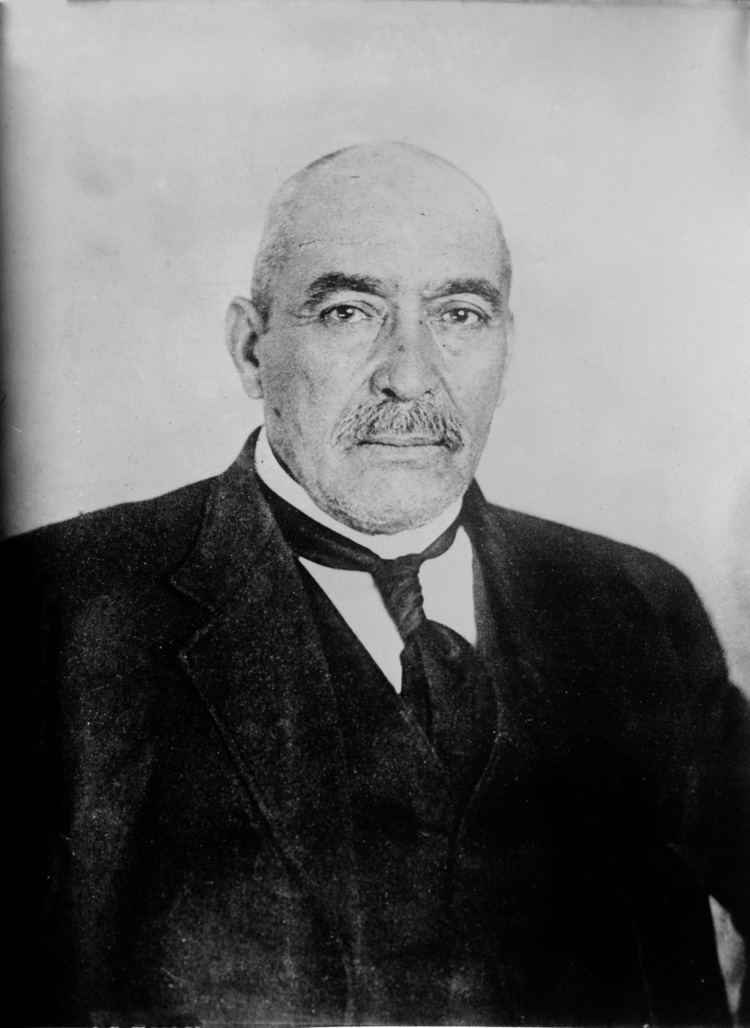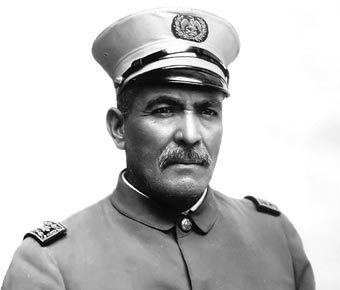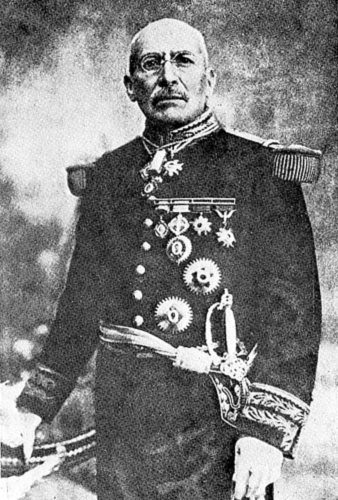Preceded by Pedro Lascurain Spouse Emilia Aguila (m. 1880) | Name Victoriano Huerta Nationality Mexican | |
 | ||
Born 22 December 1850Agua Gorda, Colotlan, JaliscoMexico ( 1850-12-22 ) Parents Jesus Huerta, Maria Lazara del Refugio Marquez Similar People | ||
Political party Independent politician | ||
Victoriano huerta
José Victoriano Huerta Márquez ([biktoˈɾjano ˈwerta]; 22 December 1850 – 13 January 1916) was a Mexican military officer and 35th President of Mexico.
Contents
- Victoriano huerta
- M xico 1916 fallece victoriano huerta
- Early life
- Military career
- Revolution
- La Mano Dura Presidency of Mexico
- Exile late life and death
- In popular culture
- References

After a military career under President Porfirio Díaz, Huerta became a high-ranking officer under pro-democracy President Francisco I. Madero during the first phase of the Mexican Revolution. In 1913, Huerta led a conspiracy against the elected president Madero who trusted him to control a minor revolt in Mexico City, deposing and assassinating Madero, his brother, and the Vice President Pino Suarez. This manoeuver is called La Decena Tragica, the Ten Tragic Days. The Huerta regime was immediately opposed by revolutionary forces, plunging the nation into a civil war and Huerta was forced to resign and flee the country in 1914, after 17 months as president after the collapse of the Federal Army. While attempting to intrigue with German spies in the United States during World War I, Huerta was arrested in 1915 and died in U.S. custody.

Huerta's supporters were known as Huertistas during the Mexican Revolution. Huerta is still vilified by modern-day Mexicans, who generally refer to him as El Chacal ("The Jackal") or El Usurpador ("The Usurper"). Barbara W. Tuchman described him as: "a pure-blooded Indian with a flat nose, a bullet head, a sphinx's eyes behind incongruous spectacles, and a brandy bottle never far from hand. Wily, patient, laconic, and rarely sober."

M xico 1916 fallece victoriano huerta
Early life

Victoriano Huerta was born in the settlement of Agua Gorda within the municipality of Colotlán, Jalisco, son of Jesús Huerta and María Lázara del Refugio Márquez. He identified himself as indigenous, and both his parents are reported to have been ethnically Huichol, although his father is said to have been Mestizo. Huerta learned to read and write at a school run by the local priest, making him one of relatively few literate people in Colotlán. Huerta had decided upon a military career early on as the only way of escaping the poverty of Colotlán. In 1869 he was employed by the visiting General Donato Guerra to serve as his personal secretary. In that role, he distinguished himself and with General Guerra's support, Huerta gained admission to the Mexican National Military Academy (Heroico Colegio Militar) at Chapultepec in Mexico City in 1872. As a cadet, Huerta excelled at math, leading him to specialize in artillery and topography. President Benito Juárez praised Cadet Huerta when inspecting the Academy, noting that the Army needed officers of indigenous origins.
Military career
Upon graduating from the military academy in 1877, Huerta was commissioned into the Corps of Engineers. After entering the Mexican Army as a lieutenant in the engineers in 1877, Huerta was put in charge of improving the Loreto and Guadalupe forts in Puebla and the Castle of Perote in Veracruz. In January 1879, Huerta was promoted to Captain and assigned to the staff of the 4th Division in Guadalajara in charge of engineering. The commander of the 4th Division was General Manual González, a close associate of President Porfirio Díaz, the dictator of Mexico. In 1880, Díaz stepped back from the limelight, turning over the presidency to González before turning to office in 1884. In the interim, Huerta's career prospered thanks to the patronage of González. Huerta married Emilia Águila Moya, whom he met in Veracruz, on 21 November 1880 in Mexico City. Together they had eleven children. The names of his children surviving him in 1916 were Jorge, María Elisa, Victor, Luz, Elena, Dagoberto, Eva and Celia. Huerta participated in the "pacification campaigns" in Tepic and Sinaloa, where he distinguished himself in combat. Huerta was known for ensuring that his men always got paid, often restoring to finding the money in ruthless ways. Following a complaint from the Catholic church that Huerta had plundered a church to sell off its gold and silver to pay his men, Huerta justified his actions on the grounds: "Mexico can do without her priests, but cannot do without her soldiers". On another occasion, following a complaint from a bank that he emptied out one of its branches at gunpoint to get money to pay his men, Huerta pointed out he left a receipt and would pay back the bank he had stolen when he received the necessary funds from Mexico City. Huerta then spent nine years of his military career undertaking topographic studies in the states of Puebla and Veracruz. He traveled extensively to all parts of Mexico in this position. French cultural influence was very strong in 19th century Mexico, and Huerta's hero was Napoleon. Huerta supported General Díaz as the closest approximation to his Napoleonic ideal, believing that Mexico needed a "strongman" to prosper.
By 1890, Huerta had reached the rank of Colonel of Engineers, under the administration of Porfirio Díaz. From 1890 to 1895, Huerta lived in Mexico City, becoming a regular visitor to the Chapultepec Castle, and was seen as part of Díaz's "court". Through Huerta was well liked at the Chapultepec Castle, acquiring the persona of a trim, efficient officer who was stern to his subordinates while displaying a courtly, polished manner towards his superiors, he began to suffer from severe insomnia and heavy drinking during this time. In January 1895, Huerta commanded a battalion of infantry against a rebellion in Guerrero led by General Canuto Neri. The rebellion was ended when Díaz brooked a deal with Neri, who surrendered in exchange for a promise to remove the unpopular state governor. Huerta confirmed his reputation for ruthlessness by refusing to take prisoners and continuing to attack the followers of Neri even after Díaz had signed a ceasefire. In December 1900, Huerta commanded a successful military campaign against Yaqui Indians in Sonora. During the near-genocidal campaign against the Yaqui, Huerta was more concerned with mapping out the terrain of Sonora, but at times he commanded forces in the field against the Yaqui. From 12 April-8 September 1901, Huerta put down a rebellion in Guerrero, completely "pacifying" the state. In May 1901, Huerta was promoted to the rank of General. In 1901-02, Huerta suppressed a Maya peoples' rising in Yucatán. Huerta commanded about 500 men in his campaign against the Maya Indians, starting in October 1901, where he fought 79 different actions over the course of 39 days. Huerta was then promoted to Brigadier General and awarded the Medal of Military Merit In May 1902, Huerta was promoted commander of the Federal Army forces in the Yucatán, and in October 1902 Huerta reported to Díaz that he had "pacified" the Yucatán. During the campaign in the Yucatán, Huerta become more and more dependent on alcohol to continue functioning, as health began to decline, perhaps because of his heavy drinking as he complained he could not go outside in the sunshine without wearing sunglasses, he suffered bouts of uncontrollable nervous shaking and his decaying teeth caused him much pain. In 1905, Huerta was appointed to head a committee tasked with reforming the uniforms of the Federal Army. In 1907, he retired from the army on grounds of ill-health, having developed cataracts while serving in the southern jungles. He then applied his technical training by taking up the position of Head of Public Works in Monterrey and planning a new street layout for the city.
Revolution
On the eve of the 1910 Revolution against the long-established Díaz regime, Huerta was teaching mathematics in Mexico City. He applied successfully to rejoin the Federal Army with his former rank. He did not play a major role in the early stages of the Revolution, although he commanded the military escort which gave Díaz safe conduct into exile, Huerta initially pledged allegiance to the new administration of Francisco Madero, and he was retained by the Madero administration to crush anti-Madero revolts by rebel generals such as Pascual Orozco. However, Huerta secretly plotted with United States Ambassador to Mexico Henry Lane Wilson, cashiered General Bernardo Reyes, and Félix Díaz, Porfirio Díaz's nephew, to overthrow Madero. This episode in Mexican history is known as La decena trágica (Ten Tragic Days). Following a confused few days of fighting in Mexico City between loyalist and rebel factions of the Army, Huerta had Madero and vice-president José María Pino Suárez seized and briefly imprisoned on 18 February 1913 in the National Palace. The conspirators then met at the U.S. Embassy to sign El Pacto de la Embajada (The Embassy Pact), which provided for the exile of Madero and Pino Suárez, and Huerta's takeover of the Mexican government.
La Mano Dura: Presidency of Mexico
To give the coup the appearance of legitimacy, Huerta had foreign minister Pedro Lascuráin assume the presidency; under the 1857 Constitution of Mexico, the foreign minister stood third in line for the presidency behind the vice-president and attorney general; Madero's attorney general had also been ousted in the coup. Lascuráin then appointed Huerta as interior minister—constitutionally, fourth in line for the presidency. After less than an hour in office (some sources say as little as 15 minutes), Lascuráin resigned, handing the presidency to Huerta. At a late-night special session of Congress surrounded by Huerta's troops, the legislators endorsed his assumption of power. Four days later Madero and Pino Suárez were taken from the National Palace to prison at night and shot by officers of the rurales (federal mounted police) who were assumed to be acting on Huerta's orders.
The British historian Alan Knight wrote about Huerta: "The consistent thread which ran through the Huerta regime, from start to finish, was militarisation: the growth and reliance on the Federal Army, the military takeover of public offices, the preference for military over political solutions, the militarisation of society in general". Even a sympathetic historian wrote Huerta "came very close to converting Mexico into the most completely militaristic state in the world." Huerta's stated goal was a return to the "order" of the Porfiriato, but his methods were unlike those of Diaz, who had shown a talent for compromise and diplomacy, seeking support from and to play off regional elites, using of not only the Army officers, but also technocrats, former guerrilla leaders, caciques and provincial elites to support his regime. By contrast, Huerta relied entirely upon the Army for support, giving Army officers all of the key jobs, regardless of their talents as Huerta sought to rule with La Mano Dura ("The Iron Hand"), believing only in military solutions to all problems. For his reason, Huerta during his short time as President won himself far more hatred than Diaz ever did; even the Zapatistas had a certain respect for Diaz as a patriarchal leader who had enough sense to finally leave with dignity in 1911 whereas Huerta was detested as a stupid, thuggish soldier who had Madero murdered and sought to terrorize the nation into submission. Huerta disliked cabinet meetings, ordered his ministers about as if they were NCOs, and displayed in general a highly autocratic style. Felix Diaz and the rest of the conservative leaders had seen Huerta as a transitional leader and pressed for early elections, which they expected to be won by Diaz on a Catholic conservative platform, and were rudely surprised when they discovered Huerta wanted to keep the presidency for himself. The Huerta government was promptly recognized by all the European governments, but the outgoing administration of William Howard Taft in the United States refused to recognize the new government as a way of pressuring Mexico to end the Chamizal border dispute in favor the United States with the plan being to trade recognition for settling the dispute on American terms. The new American president Woodrow Wilson had a general bias in favor of liberal democracy and had some distaste for General Huerta, but was initially open to recognizing Huerta provided that he could "win" an election that would give him a democratic veneer. However, Wilson, an ardent white supremacist, was annoyed at how the "iron fist" policies of Huerta which were destabilizing Mexico and causing Mexicans to flee into the United States.
Huerta moved quickly to consolidate power with the support of state governors. Chihuahua governor Abraham González refused and Huerta had him arrested and murdered in March 1913. The most important challenge from a state governor was by Venustiano Carranza, governor of Coahuila, who drafted the Plan of Guadalupe, calling for the creation of a Constitutionalist Army to oust Huerta and restore constitutional government. Supporters of Carranza's plan included Emiliano Zapata, who nonetheless remained loyal to his own Plan de Ayala, Francisco "Pancho" Villa and Álvaro Obregón. However, former revolutionary general Pascual Orozco whom Huerta fought when serving President Madero now joined with Huerta as a counter-revolutionary. Four Deputies were executed over the summer of 1913 for criticizing the Huerta regime. One deputy was arrested by the Mexico City police as he delivering a speech denouncing Huerta at a rally and taken out to the countryside where he was "shot while trying to escape". Lacking popular legitimacy, Huerta chose to turn the refusal of the United States to recognize his government as an example of American "interference" in Mexico's internal affairs, organizing anti-American demonstrations in the summer of 1913 out of the hope of gaining some popular support.
Huerta established a harsh military dictatorship. U.S. President Woodrow Wilson became hostile to the Huerta administration, recalled ambassador Henry Lane Wilson, and demanded Huerta step aside for democratic elections. In August 1913, Wilson imposed an arms embargo on Mexico, forcing Huerta to turn to Europe and Japan to buy arms. Reflecting the general disenchantment with Huerta's "iron hand" policies, a prominent conservative, Senator Belisario Domínguez of Chiapas handed out copies of a speech he did not dare to deliver in the Senate accusing Huerta of starting the civil war which he was losing, of wanting "to cover the land with corpses...rather than abandon power" and called for Congress to impeach Huerta before Mexico was plunged into the abyss. Domínguez knew he was risking his life by speaking out and sent his wife and children out of Mexico before handing out copies of his speech. Domínguez was arrested by two policemen plus Huerta's son and son-in-law, taken to a cemetery where he was "shot while trying to escape" for speaking out against the President and his body dumped into the grave that his killers had already dug for him. On 10 October 1913, when Congress announced it was opening an investigation of the disappearance of Senator Domínguez, who was last seen several days before being forced into a police car, Huerta sent his soldiers in to shut down Congress in session, and arrested 110 Senators and Deputies, of whom 74 were charged with high treason and put to work building a bull-fighting arena.
The Federal Army Huerta took over in February 1913 numbered about 45, 000-50, 000 men and reflecting the civil war he was losing, Huerta continued to increase the strength of the Army, issuing a degree for conscripting 150, 000 men in October 1913, another degree for conscripting 200, 000 men in January 1914 and a quarter of million men in March 1914, through these figures were never achieved as many men fled to fight for the Constitutionalists rather than General Huerta. Together with an increase in the number of the para-military rurales police force and the state militias, Huerta had about 300, 000 men or about 4% of the population fighting for him by early 1914. As no one wanted to fight for General Huerta, he had to resort to the leva, as vagrants, criminals, captured rebels, political prisoners, and sometimes just men on the streets were rounded up to serve in the Federal Army. In Veracruz, workers getting off the night shift at factories were rounded up in a leva while in Mexico City poor men going to hospitals were rounded up in the leva. As Indians were felt to be particularly docile and submissive to whites, the leva was applied especially heavily in the south of Mexico where the majority of the people were Indians as thousands of Juchiteco and Maya Indians were rounded up to fight a war in the north of Mexico that they felt did not concern them. A visitor to Mérida in the Yucatán wrote of "heart-breaking" scenes as hundreds of Maya Indians said goodbye to their wives as they were forced to board a train while in chains.
As the men rounded up in the leva proved to be poor soldiers, prone to desertion and mutiny, Huerta had to follow a defensive strategy of keeping the Federal Army concentrated in large towns as his soldiers in the field would either desert or go over to the rebels. Throughout the civil war of 1913-14, the Constitutionalists fought with a ferocity and courage that the Federal Army never managed. In the Yucatán, about 70% of the Federal Army were men conscripted from the prisons while one "volunteer" battalion consisted of captured Yaqui Indians. In October 1913, in the town of Tlalnepanta, the 9th Regiment of the Federal Army who were said to be "crazed with alcohol and marijuana" mutinied, murdered their officers and went over to the rebels. To provide volunteers, Huerta turned to Mexican nationalism and anti-Americanism in the fall of 1913, running spurious stories in the press warning of an imminent American invasion and asking for patriotic men to step up to defend Mexico. The patriotic campaign attracted some volunteers from the lower middle class, through the volunteers were usually disillusioned when they learned that they were going to fight other Mexicans, not the Americans. In rural Mexico, a sense of Mexican nationalism barely existed at this time among the campesinos as for most people in rural areas, Mexico was an abstract entity that meant nothing and most campesinos were primarily loyal to their own villages. Huerta's patriotic campaign was a complete failure in the countryside. The other source of volunteers was allowing for wealthy landlords to raise private armies under the guise of the state militias, but few peons wanted to fight, let alone die for General Huerta, as the Constitutionalists were promising land reform.
When Huerta refused to call elections, and with the situation further exacerbated by the Tampico Affair, President Wilson landed U.S. troops to occupy Mexico's most important seaport, Veracruz.
After repeated field defeats of the Federal Army by Obregón and Villa, climaxing in the Battle of Zacatecas, Huerta bowed to internal and external pressure and resigned the presidency on 15 July 1914.
Exile, late life and death
He went into exile, first traveling to Kingston, Jamaica, aboard the German cruiser SMS Dresden. From there, he moved to the UK, then Spain, and arrived in the United States in April 1915.
During 1915, he negotiated with Captain Franz von Rintelen of German Navy Intelligence for money to purchase weapons and arrange U-boat landings to provide support, while offering (perhaps as a bargaining chip) to make war on the U.S., which Germany hoped would end munitions supplies to the Allies. Their meetings, held at the Manhattan Hotel (as well as another New York hotel, "probably the Holland House" at Fifth Avenue and 30th Street) were observed by Secret Servicemen, and von Rintelen's telephone conversations were routinely intercepted and recorded.
Huerta traveled from New York by train to Newman, New Mexico (25 miles from the border), where he was to be met by General Pascual Orozco and some well-armed Mexican supporters. However, a U.S. Army colonel with 25 soldiers and two deputy U.S. marshals intervened and arrested him as he left the train on a charge of sedition. The German-initiated plan for Huerta to regain the Mexican presidency through a coup d'état was foiled. After some time in a U.S. Army prison at Fort Bliss, he was released on bail, but remained under house arrest due to risk of flight to Mexico. A day after he attended a dinner at Fort Bliss. Later he was returned to jail, and while so confined, died, perhaps of cirrhosis of the liver. While the main symptom was yellow jaundice, poisoning by the U.S. was widely suspected.
In popular culture
Huerta has been portrayed or referenced in any number of movies dealing with the Mexican Revolution, including The Wild Bunch, Duck, You Sucker!, and And Starring Pancho Villa as Himself.
In the 1952 film Viva Zapata!, starring Marlon Brando as Emiliano Zapata, Huerta is portrayed by Frank Silvera.
In the 1968 film Villa Rides, Huerta was portrayed by Herbert Lom.
In the novel The Friends of Pancho Villa (1996), by James Carlos Blake, Huerta is a major character.
Both Victoriano Huerta and Pancho Villa are referenced in the fourth Indiana Jones movie, Indiana Jones and the Kingdom of the Crystal Skull (2008), when Indiana (Harrison Ford) is recalling events in his childhood to his yet-to-be revealed son (Shia Lebouf). Indiana: "It was a fight against Victoriano Huerta" then Indiana spits on the ground to show disgust at Victoriano's name.
The popular song "La Cucaracha" was created for him as the first character where his affinity to alcohol and marijuana (pot) is mentioned. He always used dark rounded sunglasses to cover his constant intoxication.
